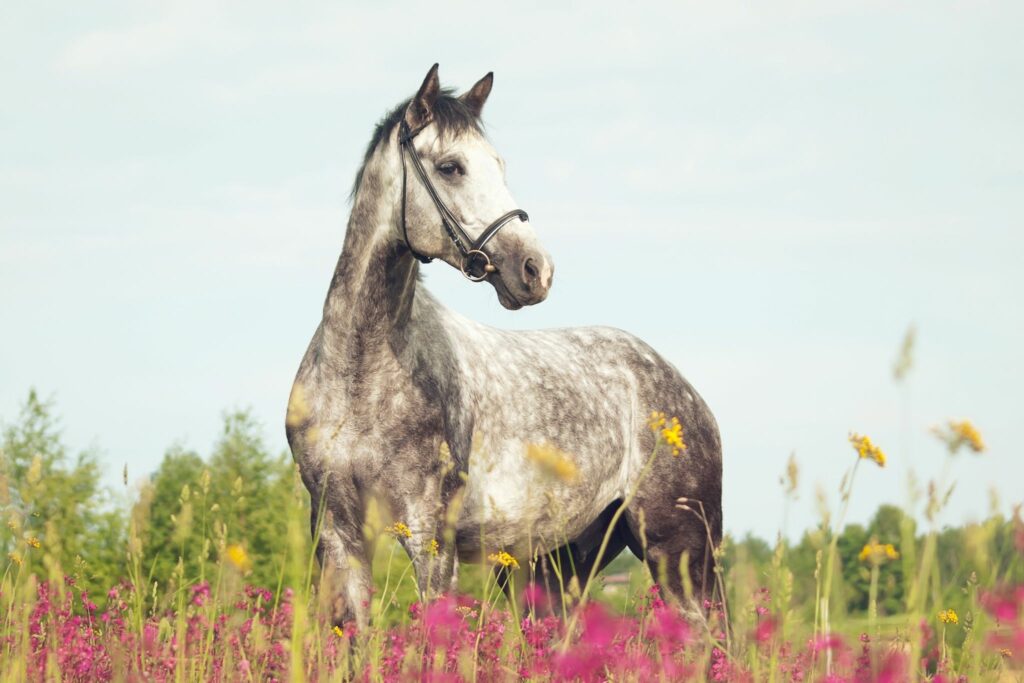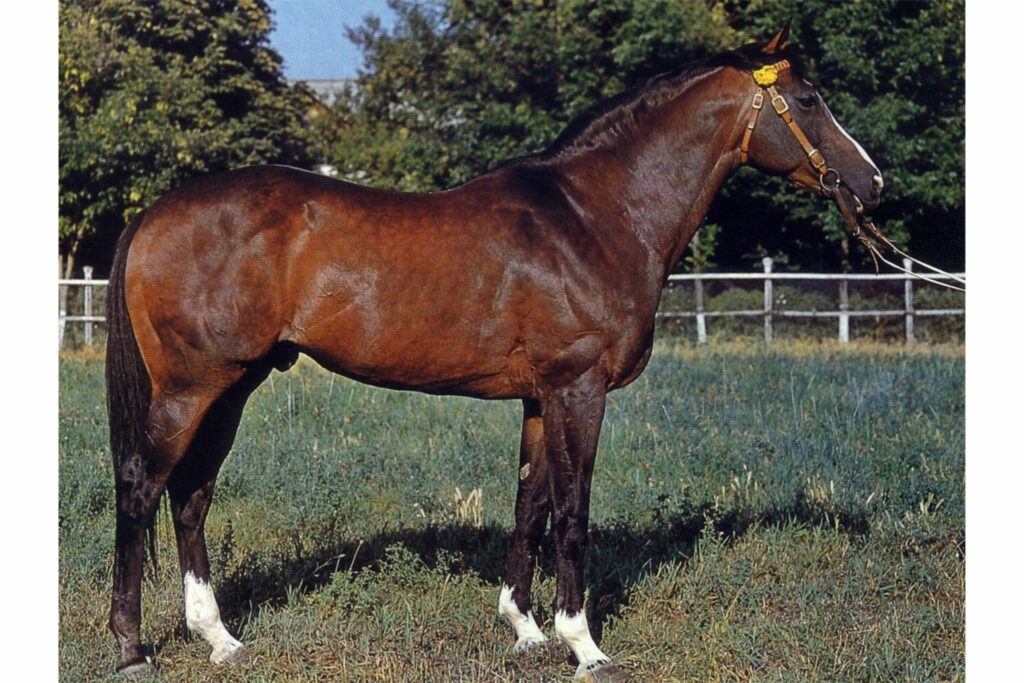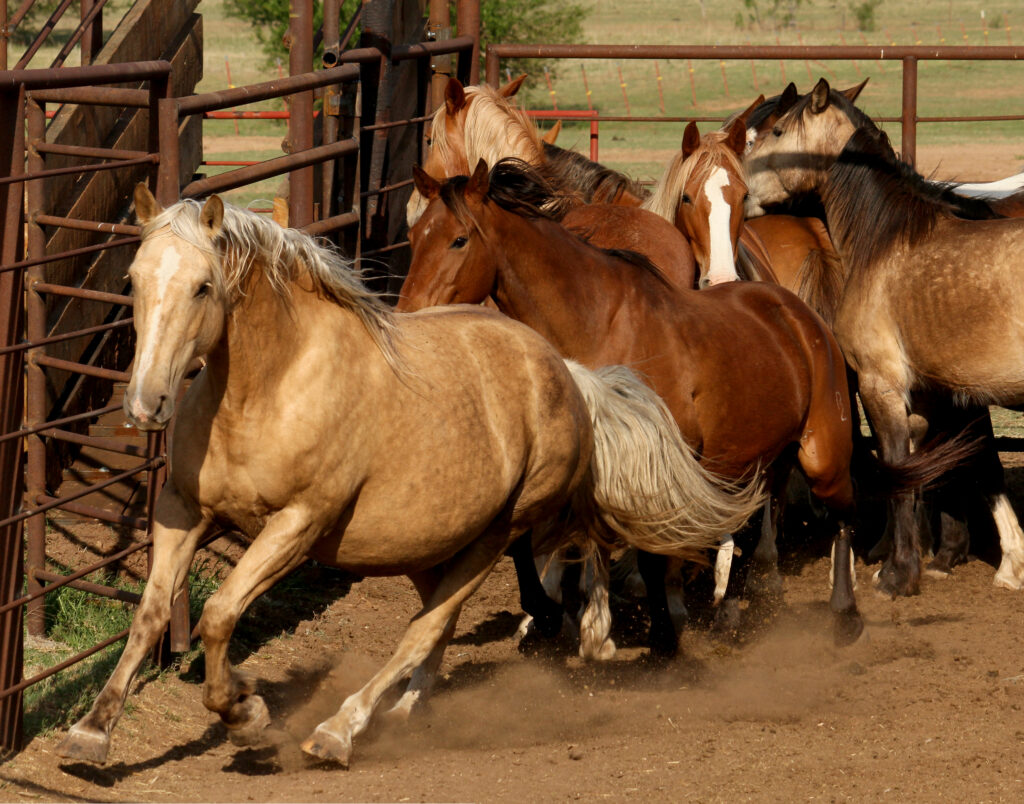Horse News
Member
Dapples on a horse? Sometimes, and here’s why.
Not much is more beautiful on a horse than dapples. These circles of lighter-colored hair make a horse sparkle and shine and draw the attention of even the most inexperienced eye.
The presence of dapples is a science that equine experts are still trying to understand. They are part genetics and part health. The colors most likely to have this stunning feature are grays, bays, and palominos. Just because your horse is predisposed to dapples doesn’t guarantee you’ll ever see them. This is where nutrition and a good grooming routine can make all the difference.

source: canva
Dapples: A Definition
According to Merriam-Webster, a dapple is “any of numerous usually cloudy rounded spots or patches of a color or shade different from their background.”
So if you have a dark gray horse, dapples on them would look like circles of varying sizes that are lighter gray.
What color horses can have dapples?
In theory, almost any horse could have a gene that causes dapples. Horses that are gray, bay, palomino, or buckskin are the most likely to have this trait, while it’s extremely rare in chestnuts. This is because dapples are caused by variations in the red and black pigments along their hair shafts.
The Dappled Gray
When most people hear the word dapple, a gray horse springs to mind. I used to own a gray horse, and many non-horse people would comment on his “dapples” (he was flea-bitten, which is slightly different, though related to dapples).
Do dappled gray horses stay that color?
Short answer? No.
Dappling is a trait that tends to come and go, eventually fading as the gray horse turns white over time. Most gray horses are born black and turn gray over time, developing their dapples as they do. Not all horses are created equally, so you may know a gray horse in his twenties that still has his dapples.

Dapples: Genetics or Condition?
This is a lot like the question “Is a tomato a fruit or a vegetable?” The current science indicates that dapples have a base in genetics, yet not all horses with the ability to dapple, do. Sometimes, it’s because the gene isn’t being expressed. Other times, the horse isn’t in optimal health, which can make a difference in whether or not you can see your horse’s dapples.
This article from Science Daily offers some cool insights into genetics and the colorings of early horses (and how it relates to the modern dapple).
What are the optimal conditions for dapples to occur?
Assuming your horse is predisposed to them (sorry, chestnut lovers), finding the right, well-balanced diet and having a stellar grooming regiment are key.
What breeds commonly have dapples?
A general rule of thumb is that any breed which can be gray or bay is likely to have dapples. Here are some of the breeds most likely to have them:
- Andalusian
- Percheron
- Irish Sport Horse
- Standardbred
- Hanoverian
- Lipizzaner
- Oldenburg
- Brandenburger
- Thoroughbred
- Quarter Horse
Feeding for Dapples
A balanced, well-rounded diet can work wonders for helping your horse’s dapples to shine. Make sure they have plenty of access to high-quality forage and that your choice of grain covers all the vitamins and minerals necessary for good health.
What supplement will add dapples?
No supplement will add dapples, but some can improve coat quality and help bring out existing dapples. According to Dr. Nerida Richards, you can try adding oils (like flaxseed or soybean oil) that are high in omega 3’s.

Grooming for Dapples
Grooming is essential if you want to see some dapples, particularly if your horse is a bay. Try to spend at least 15 minutes giving your horse’s coat a thorough cleaning.
Use a good curry comb to stir up the dirt, followed by a stiff brush. For extra shine, you can finish with a soft brush.
How can grooming help with bringing out dapples?
Grooming helps bring out dapples by allowing your horse’s natural oils to come to the surface for an incredible and natural shine. It also helps you keep on top of seasonal issues (like rain rot) which can put a damper on any horse’s coat.

Frequently Asked Questions
Q: Are dapples on a horse a sign of good health?
According to Dr. Kathleen Crandell, absolutely. A full, shiny coat is always an indicator of a healthy horse, as the coat is the last thing the horse pours its resources into. This is why horses who are underweight or lacking in nutrition often have thin, dull coats.
Q: What does a dapple horse look like?
Dapples look like round spots of lighter coloring on a darker coat. For a gray, this means a dark gray base and lighter gray circles. On a palomino, a golden coat with pale yellow or almost white circles. In bays, dapples can be harder to see as sometimes they are only a shade or two lighter.
Q: What does dappled mean?
Dappled simply means your horse is predisposed to a certain kind of marking, which can come and go based on nutrition, coat care, the seasons, if you clip them, etc. They’re rounded spots of a lighter color than the rest of the coat. Usually, they’re a sign your horse is in great health. Don’t worry if you can’t get your horse to dapple, not all horses can (even if they are super-healthy).
Q: What can I give my horse for a shiny coat?
Omega 3’s are the best way to go for a shiny coat. You can also use topical products like ShowSheen. The simplest way to help your horse’s coat shine is with some good old-fashioned elbow grease.

Click to see coat supplements at Amazon
 Parting Thoughts
Parting Thoughts

Dapples are a simple yet beautiful marking on a horse that many owners desire. Some colors, like grays, are more likely to have them, but in many other colors (with a genetic predisposition) dapples can be brought out through good nutrition and a consistent grooming routine.
I’ve owned three horses. One, a gray, was flea-bitten by the time I owned him. One, a bay OTTB, never dappled. And my third, a bay Brandenburger, sprouted dapples six months later. In my experience, it’s completely random, but so beautiful if you’re lucky enough to own a horse with this magnificent trait.
P.S. Enjoy this article? Trot on over to:
- Horse Lifespan 101 (Life Stages, Teeth, Senior Horse Care)
- Beginner’s Guide to the Best Equine Insurance (and Peace of Mind)
- How to Ride a Horse for Beginners (Basics, Safety, Mistakes)
- What to Wear Horseback Riding (With Pictures)
- Why Some Horse Wear Shoes (And Others Don’t)
Sources
Dapple Gray Horse Facts with Pictures | HorseBreedsPictures.com
What is a Dapple Gray Horse? Breeds, Facts, and Color (horseracingsense.com)
The post All About Horse Dapples (Genetics, Breeds, etc.) appeared first on Horse Rookie.
Continue reading...
